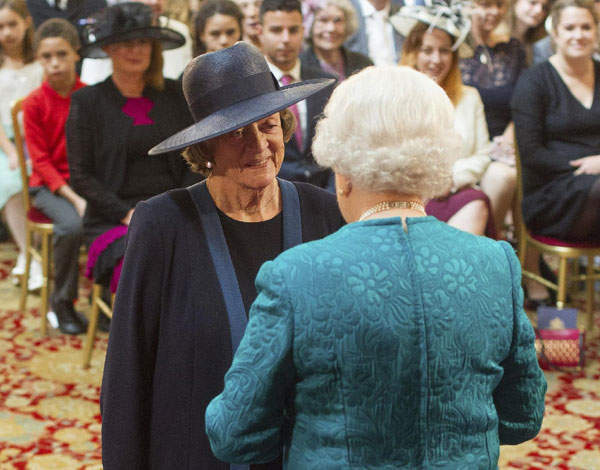

I recently attended the investiture at Windsor Castle for my father’s knighthood for over 30 years of political service. Each person receiving an honour is allowed to invite up to three guests. It was a fine October day, with the early morning mist still shrouding Windsor Great Park as the line of cars began queuing along the great avenue that stretches before Windsor Castle. Most of the cars (certainly my father’s silver 4×4, uncharacteristically mud-free) showed evidence of having been through a car wash.
Likewise the formal shoes of all honourees were shined, brushed and glistening like a Guards officer’s or a dowager countess’s (of which more later). Many shoes, bags and indeed outfits looked new. An investiture — there are around 27 a year, split between Buckingham Palace, Windsor Castle and one at the Palace of Holyroodhouse — is not the time to let your sartorial standards slide.
Nobody wants to be remembered by the hundred-plus audience of family and friends for having a mother-of-pearl button missing from your morning waistcoat.
The printed invitation card issued to each guest by the Lord Chamberlain stated ‘entry from 10 o’clock’. Since almost everybody was cautiously early, a police officer walked along the row of cars (resembling the queue to get into Car Park 1 at Royal Ascot) and said it was fine to go off and have a coffee and ‘stroll around’ Windsor.
Once we were inside the castle gates, the first thing I noticed were Her Majesty’s lawns. Never have I seen lawns so immaculate, edges so manicured, stripes so regimented and grass so glossy, Forest-of-Arden green. Thinking of my bumpy mole hills and un-scarified lawns at home in the country made me realise how a well-presented English lawn is one of our great contributions to civilisation. Windsor Castle’s lawns make Wimbledon Centre Court or the Lord’s cricket ground suddenly resemble a municipal dog-park.
We were handed smart navy-blue investiture booklets, listing all those receiving honours and the selection of music like a wedding order of service. The ceremony was in the Waterloo Chamber, a magnificent room decorated with a series of 25 paintings by Thomas Lawrence celebrating that victory in 1815. Family members and guests sit in the main chamber while those receiving honours wait in another room for their moment to be ‘presented’. Once you receive your award, you then take a seat at the back — clutching your award. I was sitting on the aisle end of an empty row near the back which meant I had a clear view of all proceedings. It all felt quite overwhelming.
There was suddenly silence. A trumpet sounded followed by the National Anthem played by a string orchestra (conducted by Major Philip Stredwick of the Corps of Army Music) assembled in a minstrel’s gallery at the back of the state chamber. The Queen then entered, attended by two Gurkha officers — a tradition going back to 1876 — and escorted by either the Lord Chamberlain, the Lord Steward or a Lord in Waiting, who stands to Her Majesty’s right and announces the name and achievement for which they are being decorated.
The first up to receive her award was Dame Maggie Smith who became Companion of Honour. The next thing I knew she was sitting next to me as the empty row of seats began filling up with honourees and their decorations. Several thoughts floated through my head as I sat in a semi-surreal state waiting for my father’s turn.
First, I never realised how much she was ‘aged up’ in Downton. The second thing that surprised me was that instead of putting down his conductor’s baton when the ceremony began, Major Stredwick’s string orchestra continued to play throughout the investiture. Perhaps this is just Royal tradition or maybe the music drowns out anybody else hearing what Her Majesty may be saying to those being decorated.
Nobody can accuse the Royal Household of being stuck in the Edwardian era when it comes to their selection of music. It was far from the sort of Vivaldi court-wallpaper music I was expecting. True, the orchestra started with Elgar’s Salut d’Amour but it wasn’t long before Major Stredwick was getting into his stride with music by John Barry from the movie Somewhere in Time, followed by ‘Bring Him Home’ from Les Misérables (Schönberg). My favourite moment was when the major played an animated rendition of ‘The Windmills of Your Mind’ from The Thomas Crown Affair.
When I saw my father walking in, it was a very proud moment. The Queen spoke with him for a short while; he refuses to say what she said: a Royal conversation, as Cameron should have known, is not for repetition. Those receiving a knighthood then kneel on a velvet Investiture Stool which is placed in front of the Queen. Her Majesty then bestows the Accolade (as it is officially termed) with the sword which King George VI used as Duke of York. It was a memorable occasion.
My only regret was that the ceremony coincided with a three-line whip for a 12.30pm vote in the Commons on the Referendum Bill. This meant my father had to leave his investiture early to catch a train to London to make the vote. Despite an attempt by my mother and brother to mutiny in favour of a family lunch, my father is not so easily swayed. Political duty prevailed.
William Cash is editor-in-chief and founder of Spear’s






